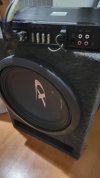Hello,
I have a PDX m12 amplifier and a alpine type x subwoofer that was used for a car audio awhile back. Both items are discontinued so awhile ago.
Goal is to have a couple speakers hooked up to PC but any chance I can hook up the amp sub combo at the same time? Sounds like it would be impractical or not worth. But if there was a way to do it wouldn't mine learning. I do not know anything but i did watch a video on DACs, so i got that part down.
Someone else stated they are doing the setup below. Would this apply the same way? Thanks
"
I just ordered up a Topping DX3Pro+ DAC/Amp and a Topping PA3s amplifier. As I understand it, I'll be able to connect as follows:
PC USB --> DX3Pro+ --> RCA in on SE8 Sub --> RCA out on SE8 Sub --> PA3s RCA in
All I should have to do is gain match the amp and the sub, set crossover and HPF on the sub and I'll have variable volume control at the DX3Pro+, while cutting sub 60Hz frequencies to the B1+ speakers."
I have a PDX m12 amplifier and a alpine type x subwoofer that was used for a car audio awhile back. Both items are discontinued so awhile ago.
Goal is to have a couple speakers hooked up to PC but any chance I can hook up the amp sub combo at the same time? Sounds like it would be impractical or not worth. But if there was a way to do it wouldn't mine learning. I do not know anything but i did watch a video on DACs, so i got that part down.
Someone else stated they are doing the setup below. Would this apply the same way? Thanks
"
I just ordered up a Topping DX3Pro+ DAC/Amp and a Topping PA3s amplifier. As I understand it, I'll be able to connect as follows:
PC USB --> DX3Pro+ --> RCA in on SE8 Sub --> RCA out on SE8 Sub --> PA3s RCA in
All I should have to do is gain match the amp and the sub, set crossover and HPF on the sub and I'll have variable volume control at the DX3Pro+, while cutting sub 60Hz frequencies to the B1+ speakers."
